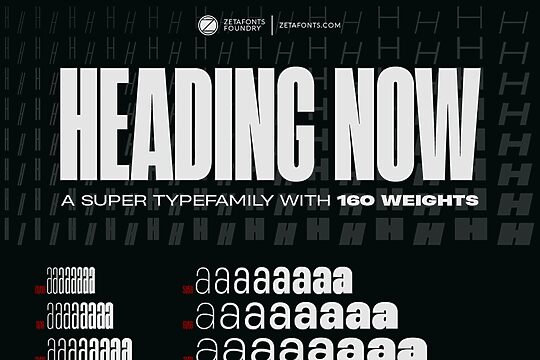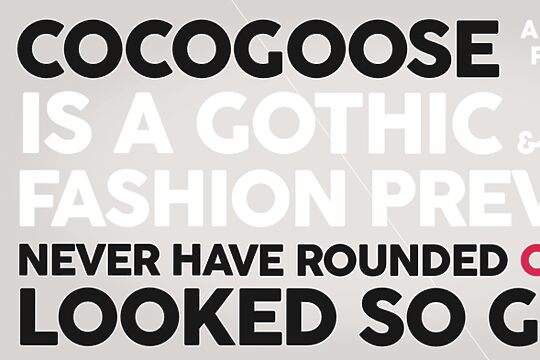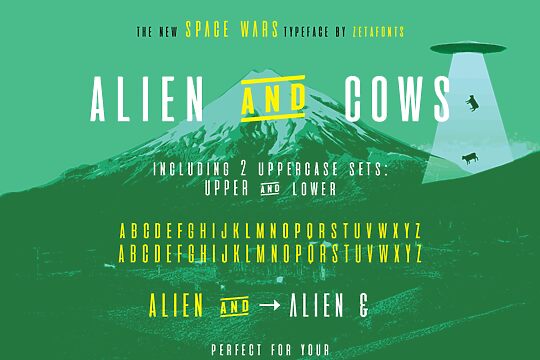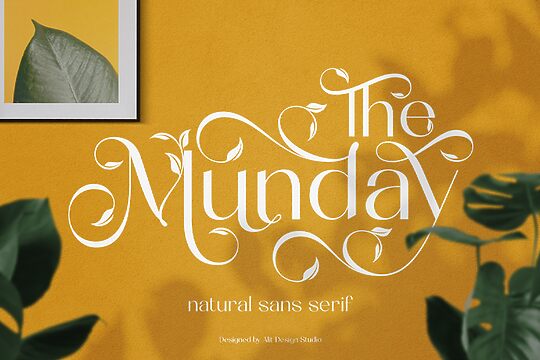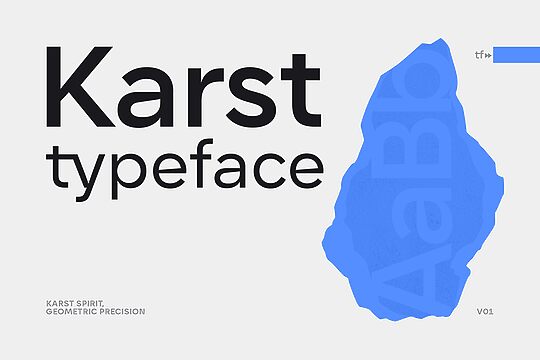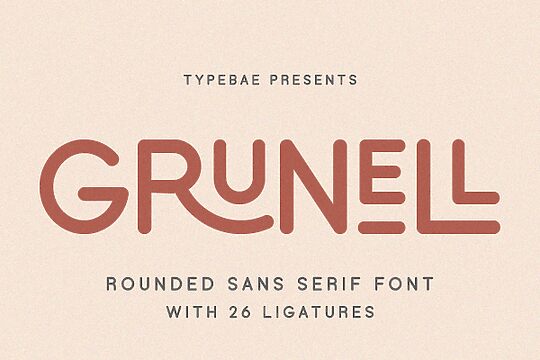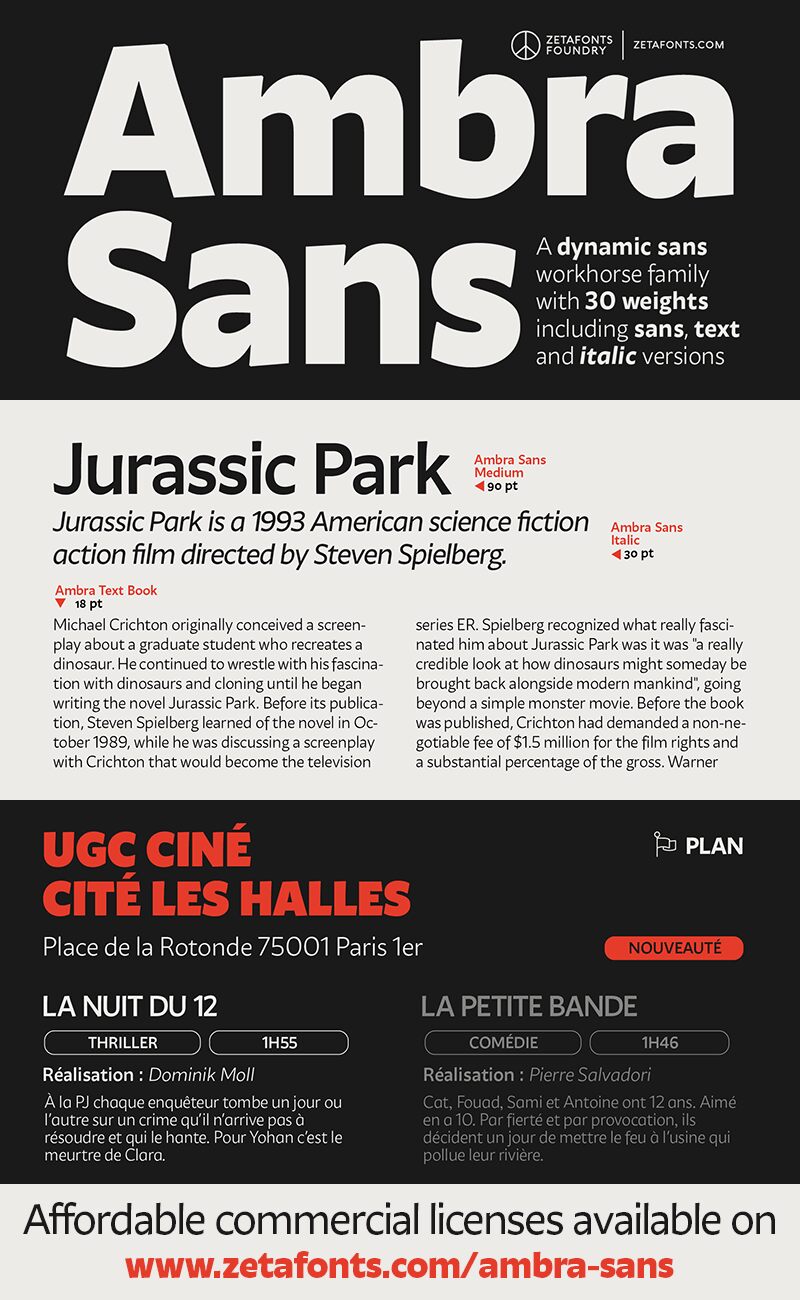
Description
Ambra Sans font family by Zetafonts is a font trio combining calligraphy, sign painting, and pop culture into a harmonious ensemble. Available in 30 font styles, each style carries a refined and elegant look informing its influence from hand-drawn designs. This culminates into a script font that’s youthful with a vintage touch. Ambra Sans’ strokes are nimble with numerous curls and tricks that bring life to each character.
Ambra Sans fonts are ideal for creative design projects in branding, packaging, and sign-making. The vintage-inspired glyph introduce a majestic feel into product labels, logotypes, and signage designs. Try it also in postcards, magazine covers, and advertising.
Use this free font in personal projects and purchase a license for commercial use.
Ambra Sans fonts are ideal for creative design projects in branding, packaging, and sign-making. The vintage-inspired glyph introduce a majestic feel into product labels, logotypes, and signage designs. Try it also in postcards, magazine covers, and advertising.
Use this free font in personal projects and purchase a license for commercial use.
Author's note
The font here is for PERSONAL/NON-COMMERCIAL USE ONLY!
To download the full font family (all weights, glyphs and numbers) and acquire the commercial license, please visit our website: https://zetafonts.com/ambra-sans
Join the exclusive Type Club to get free fonts and special offers on new releases! https://www.zetafonts.com/typeclub
CONTACT US:
Website: https://www.zetafonts.com
Email: info@zetafonts.com
Designed by Cosimo Lorenzo Pancini with Francesco Canovaro, Ambra is a humanist sans typeface family, drawn around a lively, expressive skeleton but developed with a contemporary, post-digital sensibility that implies low contrast and tall x-height.
In designing Ambra, the authors wanted to research the elusive natural signature of handmade humanist letter shapes, in the effort of preserving it while still developing all the capabilities of type as a technical tool in the digital age. Like a frail insect preserved in amber, humanist design is the "ghost in the machine" of this font, that aims at seducing the viewers with its soft, welcoming text flow, firmly opposing the rigid, formal tone of most sans serif fonts. Born to provide a useful tool to graphic designers with branding and editorial needs, Ambra develops around two subfamilies with slight but fundamental differences.
The display family offers a taller x-height, optimizing readability and spacing in headings and display use, while offering a single story lowercase g to provide more consistent branding usage. The text family, on the other side, goes for a smaller x-height to give more traditional proportion to the text and removes the slight tapering in the stems to provide better rendering on screen in small formats.
Both subfamilies of Ambra develop around a wide range of seven weights with corresponding true italics, with Ambra Display sporting an extra heavy weight for maximum versatility. In total, the family counts 30 fonts, each with over 600 glyphs for a wide language coverage. Open type features and glyph alternates further enrich the usage possibility of this typeface that wants to offer contemporary designers an alternative, unexpectedly human approach to contemporary sans type, softly preserving the spirit of handmade calligraphy while encasing its frail nature in a transparent, strong and powerful design language.
To download the full font family (all weights, glyphs and numbers) and acquire the commercial license, please visit our website: https://zetafonts.com/ambra-sans
Join the exclusive Type Club to get free fonts and special offers on new releases! https://www.zetafonts.com/typeclub
CONTACT US:
Website: https://www.zetafonts.com
Email: info@zetafonts.com
Designed by Cosimo Lorenzo Pancini with Francesco Canovaro, Ambra is a humanist sans typeface family, drawn around a lively, expressive skeleton but developed with a contemporary, post-digital sensibility that implies low contrast and tall x-height.
In designing Ambra, the authors wanted to research the elusive natural signature of handmade humanist letter shapes, in the effort of preserving it while still developing all the capabilities of type as a technical tool in the digital age. Like a frail insect preserved in amber, humanist design is the "ghost in the machine" of this font, that aims at seducing the viewers with its soft, welcoming text flow, firmly opposing the rigid, formal tone of most sans serif fonts. Born to provide a useful tool to graphic designers with branding and editorial needs, Ambra develops around two subfamilies with slight but fundamental differences.
The display family offers a taller x-height, optimizing readability and spacing in headings and display use, while offering a single story lowercase g to provide more consistent branding usage. The text family, on the other side, goes for a smaller x-height to give more traditional proportion to the text and removes the slight tapering in the stems to provide better rendering on screen in small formats.
Both subfamilies of Ambra develop around a wide range of seven weights with corresponding true italics, with Ambra Display sporting an extra heavy weight for maximum versatility. In total, the family counts 30 fonts, each with over 600 glyphs for a wide language coverage. Open type features and glyph alternates further enrich the usage possibility of this typeface that wants to offer contemporary designers an alternative, unexpectedly human approach to contemporary sans type, softly preserving the spirit of handmade calligraphy while encasing its frail nature in a transparent, strong and powerful design language.
